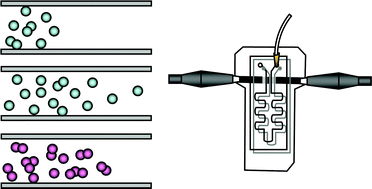A novel microfluidics-based method for probing weak protein–protein interactions
Abstract
We report the use of a novel microfluidics-based method to detect weak

* Corresponding authors
a
Institute of Materials Research and Engineering, 3 Research Link, S(117 602), Singapore
E-mail:
tancwd@imre.a-star.edu.sg
Tel: 65 6514 1521
b
Institut de Science et d'Ingénierie Supramoléculaires, 8 Allée Gaspard Monge, BP 70028 67083, France
E-mail:
I_putu_mahendra@yahoo.com
c
Institute of Materials Research and Engineering, 3 Research Link, S(117 602), Singapore
E-mail:
mirjam@starkodder.net
Tel: 65 6874 8111
d
Institute of Molecular And Cell Biology, 61 Biopolis Drive, Proteos, S
E-mail:
evasina@imcb.a-star.edu.sg
e
Institute of Materials Research and Engineering, 3 Research Link, S(117 602), Singapore
E-mail:
nallanim@imre.a-star.edu.sg
Tel: 65 6874 8111
f
Institute of Molecular And Cell Biology, 61 Biopolis Drive, Proteos, S
E-mail:
hunziker@imcb.a-star.edu.sg
g
Institute of Materials Research and Engineering, 3 Research Link, S(117 602) and University of Natural Resources and Life Sciences, Department of Nanobiotechnology, Muthgasse 11-II, 1190, Vienna
E-mail:
eva.sinner@boku.ac.at
Tel: 43 1 4765 42220
We report the use of a novel microfluidics-based method to detect weak

 Please wait while we load your content...
Something went wrong. Try again?
Please wait while we load your content...
Something went wrong. Try again?
D. C. Tan, I. P. M. Wijaya, M. Andreasson-Ochsner, E. N. Vasina, M. Nallani, W. Hunziker and E. Sinner, Lab Chip, 2012, 12, 2726 DOI: 10.1039/C2LC40228A
To request permission to reproduce material from this article, please go to the Copyright Clearance Center request page.
If you are an author contributing to an RSC publication, you do not need to request permission provided correct acknowledgement is given.
If you are the author of this article, you do not need to request permission to reproduce figures and diagrams provided correct acknowledgement is given. If you want to reproduce the whole article in a third-party publication (excluding your thesis/dissertation for which permission is not required) please go to the Copyright Clearance Center request page.
Read more about how to correctly acknowledge RSC content.
 Fetching data from CrossRef.
Fetching data from CrossRef.
This may take some time to load.
Loading related content
